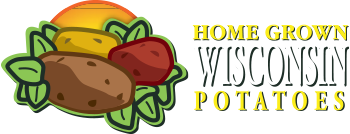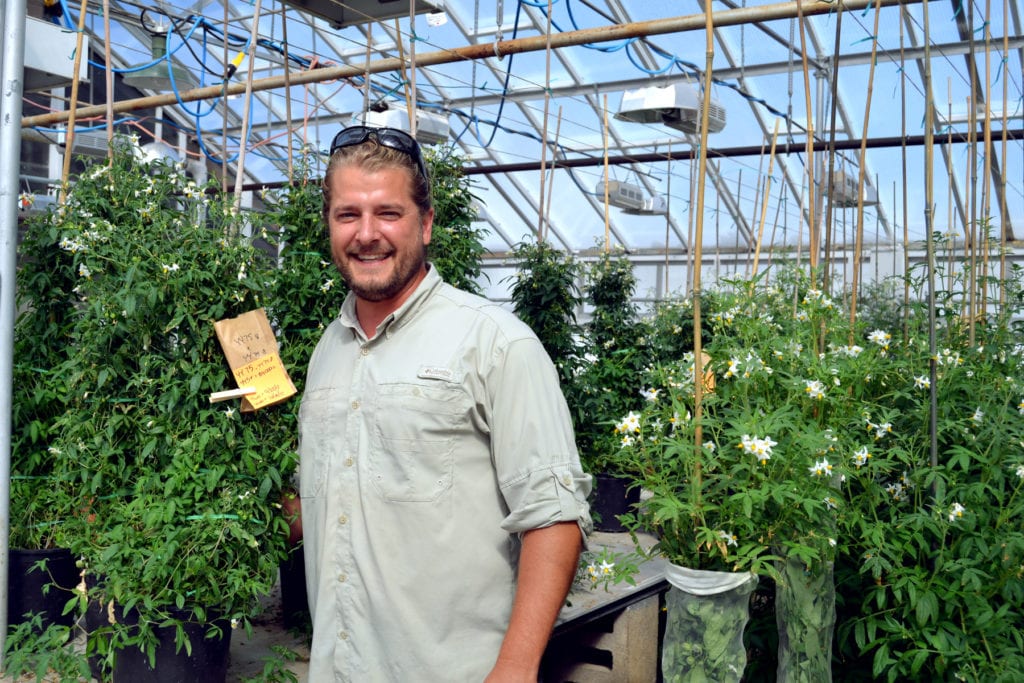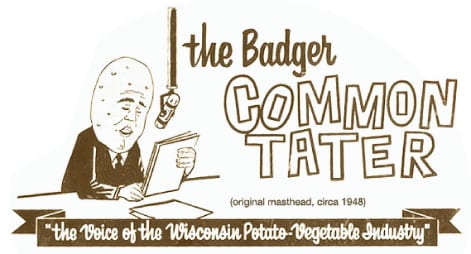
Insuring Genetic Diversity Through Germplasm Collection
By Amy Charkowski, Proefessor, UW-Madison/Dept. of Plant Pathology, Administrative Director, Wisconsin Seed Potato Certification Program
Photos by Ruth Faivre
This fall, Keith Heinzen and the staff at the Lelah Starks Elite Foundation Seed Potato Farm in Rhinelander harvested another excellent seed potato crop.
The farm had an enviable problem this year because yields were unexpectedly high. However, that meant they had to ship some seed immediately because the farm lacks sufficient storage for the entire crop.

The numerous varieties produced by University staff on the Starks Seed Farm serve as the seed stock for much of the Wisconsin seed potato industry and eventually become about 5% of US potato production.
Almost every year, the Starks Seed Farm introduces at least one new variety into production in the hope that improved traits, such as storage quality, will result in the new variety replacing old standbys, not possessing such traits.
New York’s Lamoka and Wisconsin’s Red Endeavor are just two examples of the types of new varieties grown in the past few years at the Starks Seed Farm.
SOURCES
These new potato varieties originate from potato breeding programs across North America who turn to the U.S. Potato Genebank (USPG) in Sturgeon Bay, WI for the source of the potato genes used to generate new strains for farmers.

USPG is a cooperative project between the U.S. Department of Agriculture’s Agriculture Research Service (USDA/ARS) and all 50 State Agricultural Experiment Stations (SAES) with special support from the University of Wisconsin.
It is the only federal facility designated to support the germplasm needs of the US potato industry and is home to the most comprehensive and active collection of wild potatoes in the world.
As plant breeders begin their research into creating more disease-resistant, nutrient-rich traits or other desired aspects, like a greater capacity to endure environmental stress or prolonged storage, they first request stocks from USPG, which are provided free of charge. Nearly 70 percent of all potatoes grown in the United States contain germplasm from USPG in their pedigrees.
The breeders then work toward building a better potato, a lengthy process that can span up to 15 years, as a variety is created, tested, grown, retested, grown as seed potatoes, then eventually planted by commercial growers and finally introduced to processors and/or the retail chain and ultimately to the consumers.
BACKGROUND

Project Leader, Dr. John Bamberg and his staff of scientists, gardeners, technicians, database experts and assistants, manage USPG.
Dr. Bamberg has a PhD from the UW-Madison Dept. of Horticulture in Plant Breeding and Plant Genetics, is the Editor in Chief of the American Journal of Potato Research and serves as Chairman of the Potato Crop Germplasm Committee.
USPG’s Sturgeon Bay location was chosen primarily for its climate and because it was important to potato scientists from Wisconsin when the idea of a genebank was first developed in the late 1940’s. It was decided that it should be located far from the large potato crops of Wisconsin, Idaho, Washington and North Dakota, to reduce any possible spread of disease from nearby farms.
USPG is entwined with UW-Madison, which is quite probably the world’s center for potato breeding research.
As part of its College of Agriculture and Life Sciences, the university runs 13 experimental farms, or research stations, across the state.

USPG has gathered and guarded the potato genes of the world and coordinated all aspects of importation, classification, preservation and multiplication, documentation and distribution of germplasm, thereby helping the agricultural world produce and create a better food supply.
Dr. Bamberg and USPG staff also conduct research in cooperation with U.S. and international scientists focused on collecting, classifying, preserving, evaluating and using the germplasm. For example, a longstanding partnership with UW physiologist Dr. Jiwan Palta has resulted in much progress in identifying and characterizing frost and other stress resistances.
USDA/ARS researchers at Madison like taxonomist Dr. David Spooner and germplasm enhancement specialist Dr. Shelley Jansky have formal ties to the USPG program
Dr. Spooner and colleagues from South and Central America conducted regular trips collecting wild potato species from throughout the Americas.
During these trips, they would gather diverse potato species from along the road, mountainsides, farmers’ fields, ancient ruins, abandoned villages and more.

The location and habitat of each plant was recorded and specimens were returned to Sturgeon Bay. These specimens were then referred to as an ‘accession’.
Each species housed at USPG may be represented by multiple accessions collected from different locations and in different years, hopefully then representing the biological diversity found within each species as they ‘weather’ the years.
TRAVELS CUT SHORT
However, these collection trips are now mostly a ‘thing of the past’, as countries with the greatest wild potato diversity began to recognize the value of these plants and realized that they should remain within their borders unless mechanisms for returning the value of the plant to its original country were developed and used.
The problem is that even though we harvest valuable genetic traits from wild potato relatives, no mechanism exists to insure that a partial value of the improved potato lines is returned to help maintain the environments or communities from which the original wild potato species are collected.
This lack of a feedback loop has resulted in borders now being closed to potato collection.
Luckily, two wild potato species originate in the southwest USA, and have been the focus of collecting and research by USPG staff for over 20 years. That initiative has made it possible to gain a much better understanding of the relationship between germplasm in the wild and in the genebank.

ORGANIZATION
USPG Database Manager Jesse Schartner catalogues the seeds and related information from each accession in a database known as the Germplasm Resources Information Network (GRIN) database.
It is all freely accessible online, linked to the USPG website, www.ars-grin.gov/nr6. Here you can discover traits and collection location for each accession with simple searches.
GROWING PROCESS
Although potato seed can be stored for many years, the seed will eventually lose viability. Therefore, Bamberg’s team grows a portion of the accessions each year to generate new seed.

Members of the USPG team carefully hand pollinate the potato plant flowers with a modified electric toothbrush tool that mimics the vibration of a buzzing bumblebee, the natural pollinator of potato flowers.
Once the plants are pollinated, the potato plant, which is closely related to the tomato plant, will produce fruits filled with tiny beige seeds, just like tomatoes. However, unlike tomatoes, the fruit of potatoes is small, green and inedible.
After several weeks, the potato fruit is collected and its seeds are harvested and stored in a large freezer with part of the seeds separated into a section designated for long-term storage and the other half in a section for researcher requests. A long-term security backup sample is sent to the base genebank in Ft. Collins, Colorado.
In addition to potato researchers and breeders, other individuals interested in potato propagation can also request seed samples from the USPG.

PROTECTING THIS VALUABLE RESOURCE
It is amazing that these six thousand wild potato accessions, which form the basis of our nation’s potato breeding program and comprise the future of our potato industry, are managed by a very small staff in a few aging buildings.
The primary equipment used to maintain and store this genetic gold mine is simply a small greenhouse complex, a few large freezers, a modest tissue culture and disease-testing lab, modified toothbrushes and thousands of tiny, labeled envelopes. There also is a tissue culture laboratory, growth chambers and such to support the in vitro collection.
As technology for germplasm evaluation and breeding rapidly advances, and the need for potato improvement intensifies, it will be increasingly important to adequately support the USPG program so that its germplasm can be used to make maximum progress toward an even more nutritious and

profitable crop.
GENETIC DIVERSITY
Potatoes are an interesting crop for many reasons, but one of the most fascinating things about potatoes compared to many other important crop plants is that incredibly diverse wild potato species are found everywhere from the deserts of the American Southwest to Peruvian jungles to the sparse dry heights of Andean mountainsides.
This means that there is almost an endless universe of useful traits that potato breeders can utilize in their quest for improving potato varieties.
The challenge is to find the wild potato accession that has the desired trait and then to figure out how to transfer the trait to a commercial potato variety.
This is where the USPG staff comes into play because they routinely work with the entire, broad array of potato genetic diversity. Therefore, they have gained a special insight to notice and describe novel traits that might have application.
USDA/USPG scientists have identified core collections of wild potato species that represent the diversity of the biological, geography and ecology diversity of potatoes. This core collection is one of the common starting points for researchers looking for specific potato traits.

This has led to the identification of stocks that have extreme expression of valuable traits like high tuber calcium, male fertility under heat stress, nitrogen use efficiency, late blight, virus Y and scab resistance, antioxidants and tuber pH.
For many years, USPG has used a “mini-core” set of 75 items composed of three populations each of 25 representative species (Hardigan et al. 2015). We could conclude that this mini-core set has also been well validated by phenotypic evaluation, finding desirable germplasm for traits for which there was limited prior information: Tuber calcium (Bamberg et al. 1993), male fertility under heat stress (Bamberg 1995), nitrogen use efficiency (Errebhi et al. 1999), new forms of late blight (Douches et al. 2001), antioxidants (Hale et al. 2008) and tuber pH (Kiszonas and Bamberg 2010).
Dr. Shelley Jansky refers to herself as a potato pre-breeder, which means she identifies wild potato accessions that have important traits and then crosses those traits into lines that potato breeders can use in commercial breeding programs.

These new lines are then maintained by the staff at USPG and can be requested by researchers, breeders and private individuals.
When possible, the Jansky lab will develop PCR-based tests, known as “molecular markers” to allow potato breeders to ensure that important traits are being maintained as they breed new potato varieties.
Staff member Dr. Alfonso del Rio, stationed at Madison, also specializes in the use of molecular markers to support USPG’s program of studying the status and dynamics of genetic diversity in the genebank.
Dr. del Rio, a native Peruvian, serves as liaison for cooperative projects in Latin America, particularly Peru.
USPG also maintains a collection of named potato varieties, including a collection of heirloom varieties from around the world that have interesting traits, such as high levels of nutrients or deep yellow flesh.
These varieties are kept as tissue culture plantlets. Like the wild potato seeds, the plantlets are catalogued in the GRIN database and can be ordered by those interested in producing these varieties or in using them in breeding programs.
These lines are used by potato breeders, including Jeff Endelman, the UW-Madison potato breeder, to develop new potato varieties with improved traits, such as longer storability or disease resistance.
Eventually, these new varieties, with genes that can be traced to a plant growing many years ago in a farm field or remote hillside, will be grown on the Lelah Starks seed potato farm, distributed to Wisconsin seed potato farmers, and ultimately, find their way to our tables.


